Taxation, Theory & Practice: Capital Gain Tax, Income Analysis
VerifiedAdded on 2023/03/29
|8
|1661
|124
Homework Assignment
AI Summary
This assignment provides solutions to questions related to Australian income tax law, focusing on capital gains and income from personal exertion. It analyzes scenarios involving the sale of assets acquired before and after the introduction of capital gains tax, applying the indexation method to calculate capital gains or losses. The assignment also examines the concept of income from personal exertion, differentiating it from capital income, and discusses the tax implications of financial assistance provided by parents to their children. The solutions reference relevant sections of the ITAA 1997 and case law to support the analysis. Desklib offers a platform for students to access similar solved assignments and study resources.
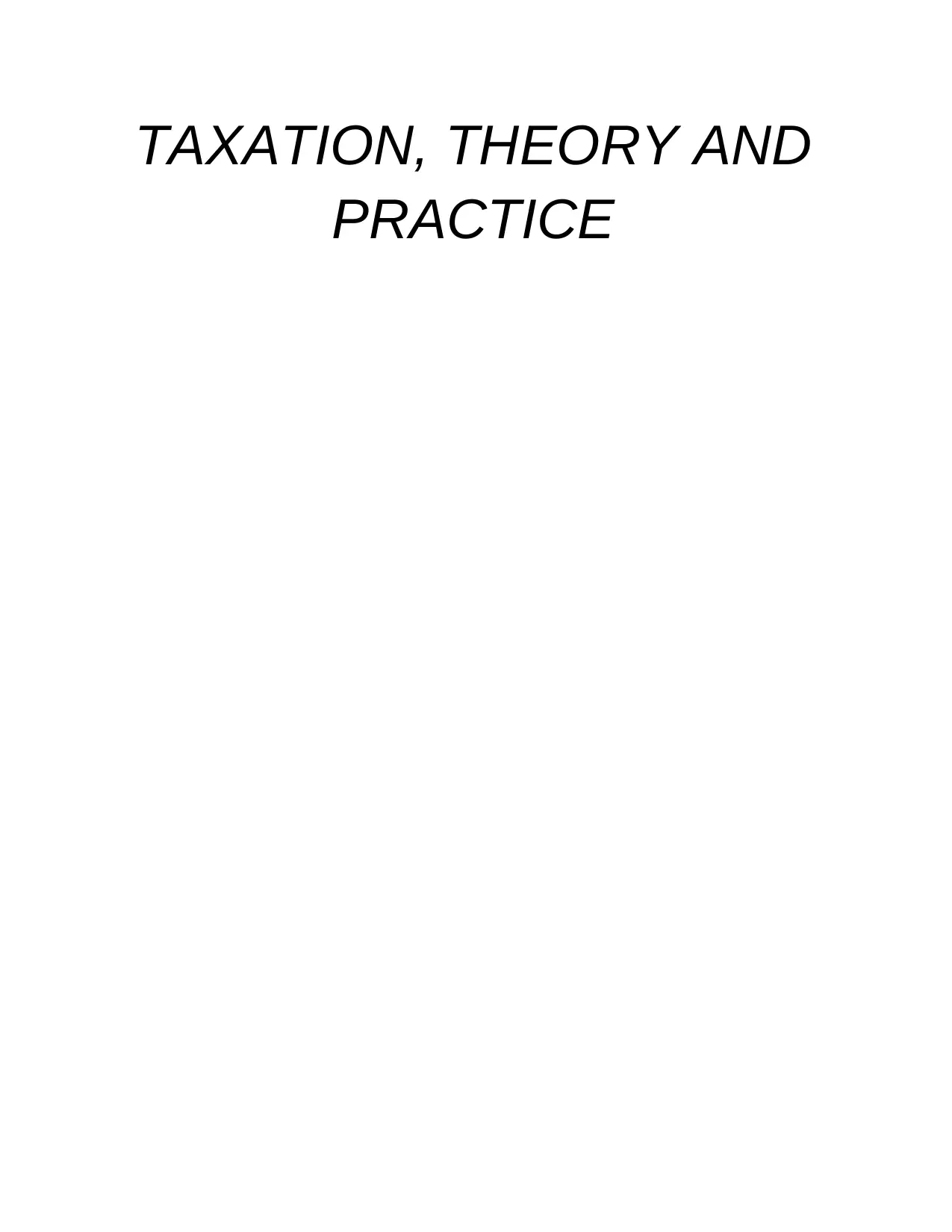
TAXATION, THEORY AND
PRACTICE
PRACTICE
Paraphrase This Document
Need a fresh take? Get an instant paraphrase of this document with our AI Paraphraser
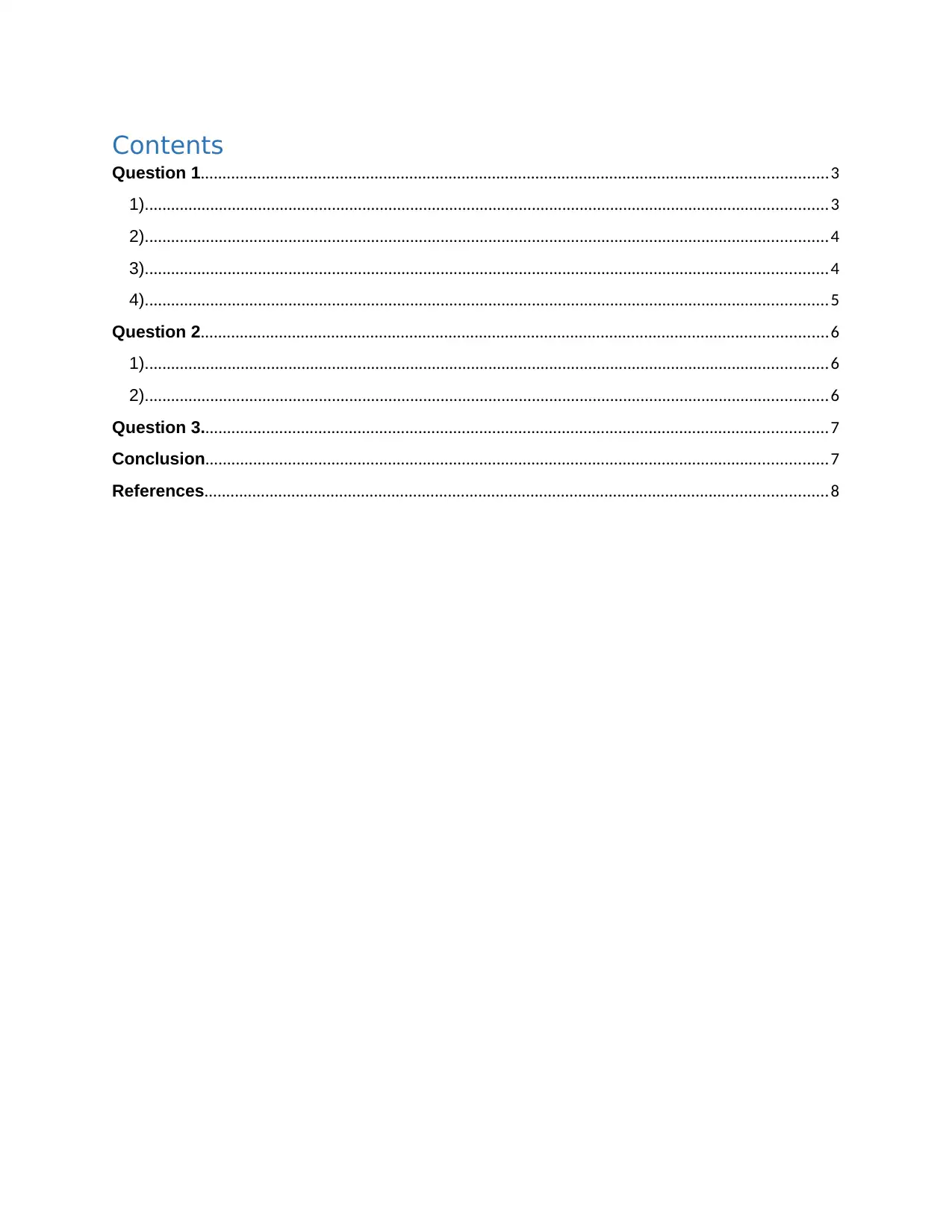
Contents
Question 1................................................................................................................................................3
1).............................................................................................................................................................3
2).............................................................................................................................................................4
3).............................................................................................................................................................4
4).............................................................................................................................................................5
Question 2................................................................................................................................................6
1).............................................................................................................................................................6
2).............................................................................................................................................................6
Question 3................................................................................................................................................7
Conclusion...............................................................................................................................................7
References...............................................................................................................................................8
Question 1................................................................................................................................................3
1).............................................................................................................................................................3
2).............................................................................................................................................................4
3).............................................................................................................................................................4
4).............................................................................................................................................................5
Question 2................................................................................................................................................6
1).............................................................................................................................................................6
2).............................................................................................................................................................6
Question 3................................................................................................................................................7
Conclusion...............................................................................................................................................7
References...............................................................................................................................................8
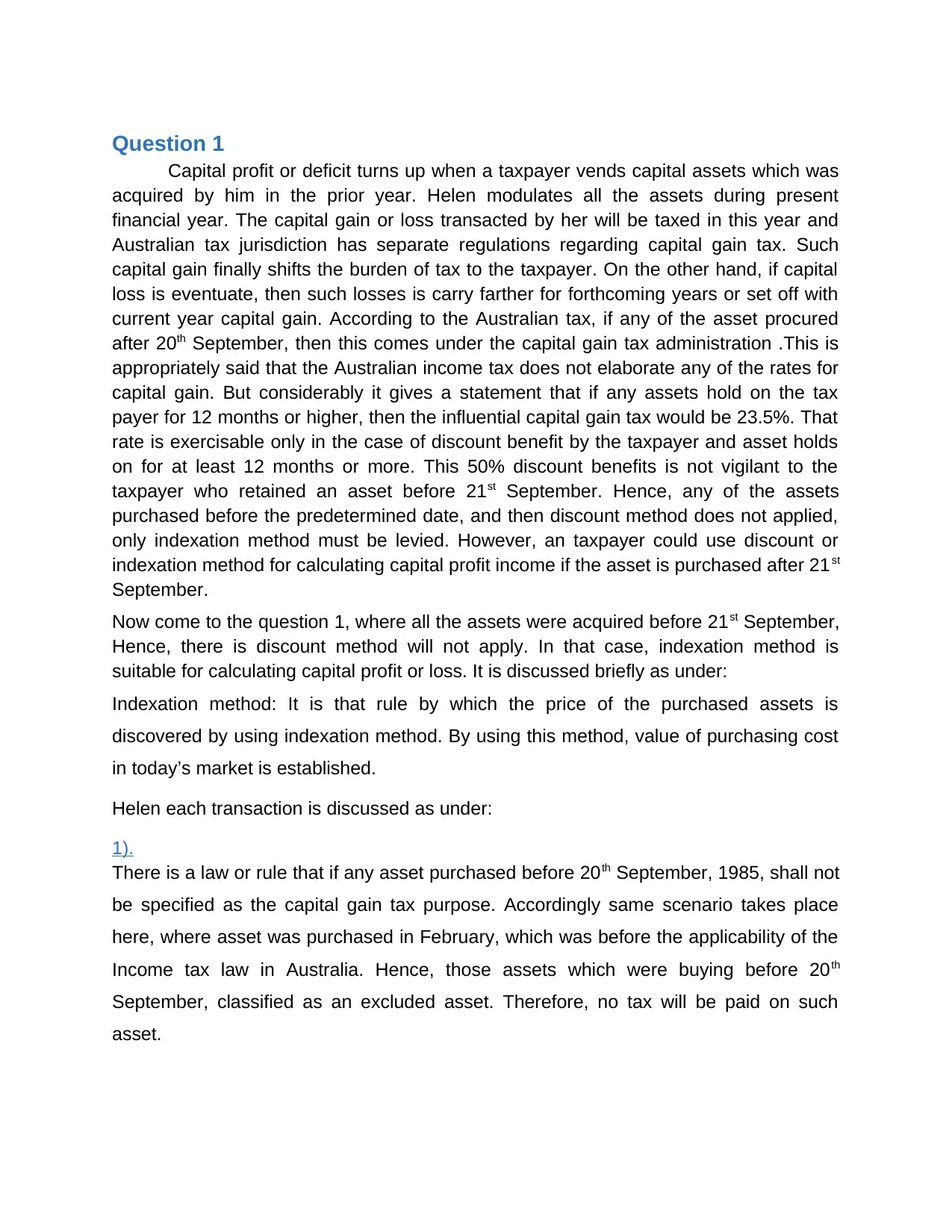
Question 1
Capital profit or deficit turns up when a taxpayer vends capital assets which was
acquired by him in the prior year. Helen modulates all the assets during present
financial year. The capital gain or loss transacted by her will be taxed in this year and
Australian tax jurisdiction has separate regulations regarding capital gain tax. Such
capital gain finally shifts the burden of tax to the taxpayer. On the other hand, if capital
loss is eventuate, then such losses is carry farther for forthcoming years or set off with
current year capital gain. According to the Australian tax, if any of the asset procured
after 20th September, then this comes under the capital gain tax administration .This is
appropriately said that the Australian income tax does not elaborate any of the rates for
capital gain. But considerably it gives a statement that if any assets hold on the tax
payer for 12 months or higher, then the influential capital gain tax would be 23.5%. That
rate is exercisable only in the case of discount benefit by the taxpayer and asset holds
on for at least 12 months or more. This 50% discount benefits is not vigilant to the
taxpayer who retained an asset before 21st September. Hence, any of the assets
purchased before the predetermined date, and then discount method does not applied,
only indexation method must be levied. However, an taxpayer could use discount or
indexation method for calculating capital profit income if the asset is purchased after 21st
September.
Now come to the question 1, where all the assets were acquired before 21st September,
Hence, there is discount method will not apply. In that case, indexation method is
suitable for calculating capital profit or loss. It is discussed briefly as under:
Indexation method: It is that rule by which the price of the purchased assets is
discovered by using indexation method. By using this method, value of purchasing cost
in today’s market is established.
Helen each transaction is discussed as under:
1).
There is a law or rule that if any asset purchased before 20th September, 1985, shall not
be specified as the capital gain tax purpose. Accordingly same scenario takes place
here, where asset was purchased in February, which was before the applicability of the
Income tax law in Australia. Hence, those assets which were buying before 20th
September, classified as an excluded asset. Therefore, no tax will be paid on such
asset.
Capital profit or deficit turns up when a taxpayer vends capital assets which was
acquired by him in the prior year. Helen modulates all the assets during present
financial year. The capital gain or loss transacted by her will be taxed in this year and
Australian tax jurisdiction has separate regulations regarding capital gain tax. Such
capital gain finally shifts the burden of tax to the taxpayer. On the other hand, if capital
loss is eventuate, then such losses is carry farther for forthcoming years or set off with
current year capital gain. According to the Australian tax, if any of the asset procured
after 20th September, then this comes under the capital gain tax administration .This is
appropriately said that the Australian income tax does not elaborate any of the rates for
capital gain. But considerably it gives a statement that if any assets hold on the tax
payer for 12 months or higher, then the influential capital gain tax would be 23.5%. That
rate is exercisable only in the case of discount benefit by the taxpayer and asset holds
on for at least 12 months or more. This 50% discount benefits is not vigilant to the
taxpayer who retained an asset before 21st September. Hence, any of the assets
purchased before the predetermined date, and then discount method does not applied,
only indexation method must be levied. However, an taxpayer could use discount or
indexation method for calculating capital profit income if the asset is purchased after 21st
September.
Now come to the question 1, where all the assets were acquired before 21st September,
Hence, there is discount method will not apply. In that case, indexation method is
suitable for calculating capital profit or loss. It is discussed briefly as under:
Indexation method: It is that rule by which the price of the purchased assets is
discovered by using indexation method. By using this method, value of purchasing cost
in today’s market is established.
Helen each transaction is discussed as under:
1).
There is a law or rule that if any asset purchased before 20th September, 1985, shall not
be specified as the capital gain tax purpose. Accordingly same scenario takes place
here, where asset was purchased in February, which was before the applicability of the
Income tax law in Australia. Hence, those assets which were buying before 20th
September, classified as an excluded asset. Therefore, no tax will be paid on such
asset.
⊘ This is a preview!⊘
Do you want full access?
Subscribe today to unlock all pages.

Trusted by 1+ million students worldwide
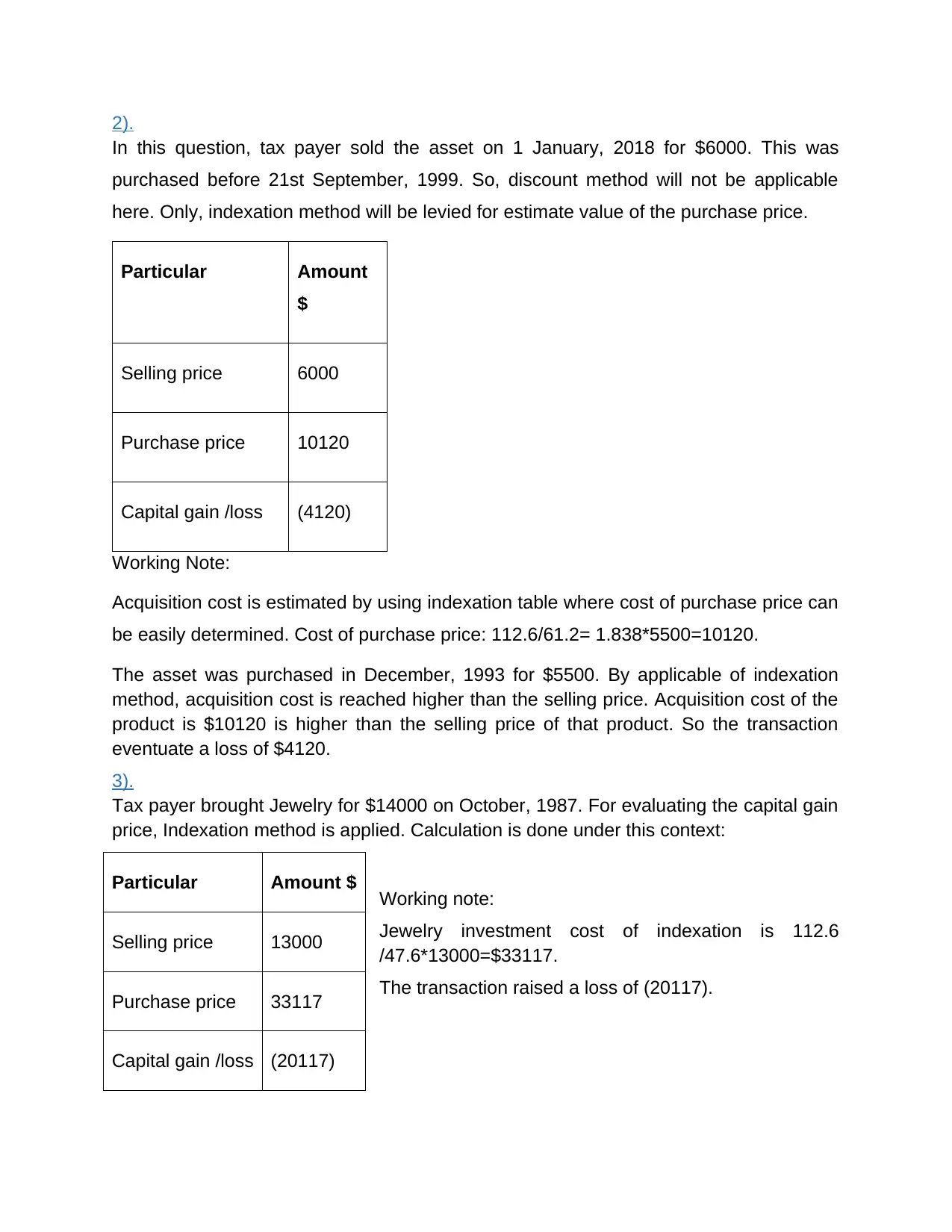
2).
In this question, tax payer sold the asset on 1 January, 2018 for $6000. This was
purchased before 21st September, 1999. So, discount method will not be applicable
here. Only, indexation method will be levied for estimate value of the purchase price.
Particular Amount
$
Selling price 6000
Purchase price 10120
Capital gain /loss (4120)
Working Note:
Acquisition cost is estimated by using indexation table where cost of purchase price can
be easily determined. Cost of purchase price: 112.6/61.2= 1.838*5500=10120.
The asset was purchased in December, 1993 for $5500. By applicable of indexation
method, acquisition cost is reached higher than the selling price. Acquisition cost of the
product is $10120 is higher than the selling price of that product. So the transaction
eventuate a loss of $4120.
3).
Tax payer brought Jewelry for $14000 on October, 1987. For evaluating the capital gain
price, Indexation method is applied. Calculation is done under this context:
Working note:
Jewelry investment cost of indexation is 112.6
/47.6*13000=$33117.
The transaction raised a loss of (20117).
Particular Amount $
Selling price 13000
Purchase price 33117
Capital gain /loss (20117)
In this question, tax payer sold the asset on 1 January, 2018 for $6000. This was
purchased before 21st September, 1999. So, discount method will not be applicable
here. Only, indexation method will be levied for estimate value of the purchase price.
Particular Amount
$
Selling price 6000
Purchase price 10120
Capital gain /loss (4120)
Working Note:
Acquisition cost is estimated by using indexation table where cost of purchase price can
be easily determined. Cost of purchase price: 112.6/61.2= 1.838*5500=10120.
The asset was purchased in December, 1993 for $5500. By applicable of indexation
method, acquisition cost is reached higher than the selling price. Acquisition cost of the
product is $10120 is higher than the selling price of that product. So the transaction
eventuate a loss of $4120.
3).
Tax payer brought Jewelry for $14000 on October, 1987. For evaluating the capital gain
price, Indexation method is applied. Calculation is done under this context:
Working note:
Jewelry investment cost of indexation is 112.6
/47.6*13000=$33117.
The transaction raised a loss of (20117).
Particular Amount $
Selling price 13000
Purchase price 33117
Capital gain /loss (20117)
Paraphrase This Document
Need a fresh take? Get an instant paraphrase of this document with our AI Paraphraser
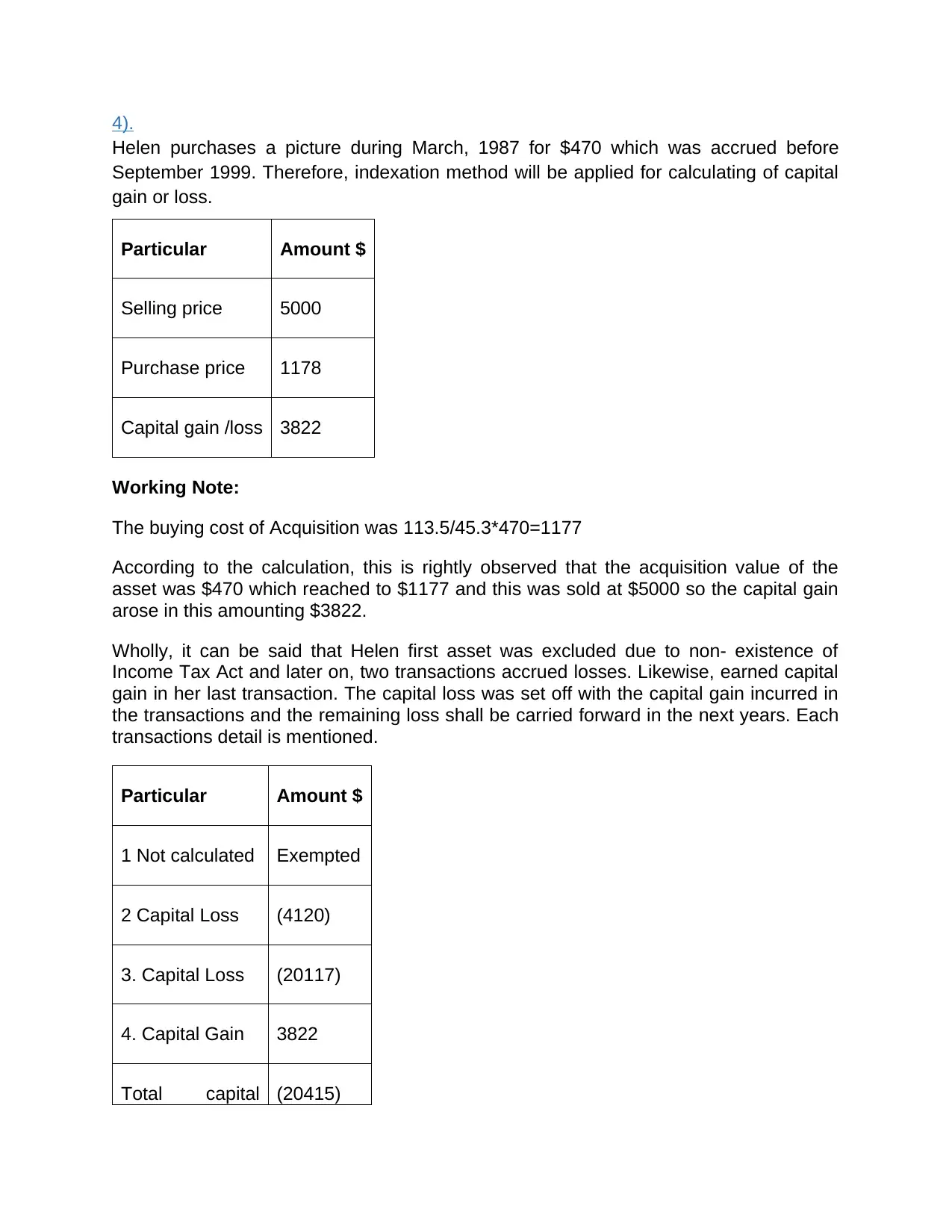
4).
Helen purchases a picture during March, 1987 for $470 which was accrued before
September 1999. Therefore, indexation method will be applied for calculating of capital
gain or loss.
Particular Amount $
Selling price 5000
Purchase price 1178
Capital gain /loss 3822
Working Note:
The buying cost of Acquisition was 113.5/45.3*470=1177
According to the calculation, this is rightly observed that the acquisition value of the
asset was $470 which reached to $1177 and this was sold at $5000 so the capital gain
arose in this amounting $3822.
Wholly, it can be said that Helen first asset was excluded due to non- existence of
Income Tax Act and later on, two transactions accrued losses. Likewise, earned capital
gain in her last transaction. The capital loss was set off with the capital gain incurred in
the transactions and the remaining loss shall be carried forward in the next years. Each
transactions detail is mentioned.
Particular Amount $
1 Not calculated Exempted
2 Capital Loss (4120)
3. Capital Loss (20117)
4. Capital Gain 3822
Total capital (20415)
Helen purchases a picture during March, 1987 for $470 which was accrued before
September 1999. Therefore, indexation method will be applied for calculating of capital
gain or loss.
Particular Amount $
Selling price 5000
Purchase price 1178
Capital gain /loss 3822
Working Note:
The buying cost of Acquisition was 113.5/45.3*470=1177
According to the calculation, this is rightly observed that the acquisition value of the
asset was $470 which reached to $1177 and this was sold at $5000 so the capital gain
arose in this amounting $3822.
Wholly, it can be said that Helen first asset was excluded due to non- existence of
Income Tax Act and later on, two transactions accrued losses. Likewise, earned capital
gain in her last transaction. The capital loss was set off with the capital gain incurred in
the transactions and the remaining loss shall be carried forward in the next years. Each
transactions detail is mentioned.
Particular Amount $
1 Not calculated Exempted
2 Capital Loss (4120)
3. Capital Loss (20117)
4. Capital Gain 3822
Total capital (20415)
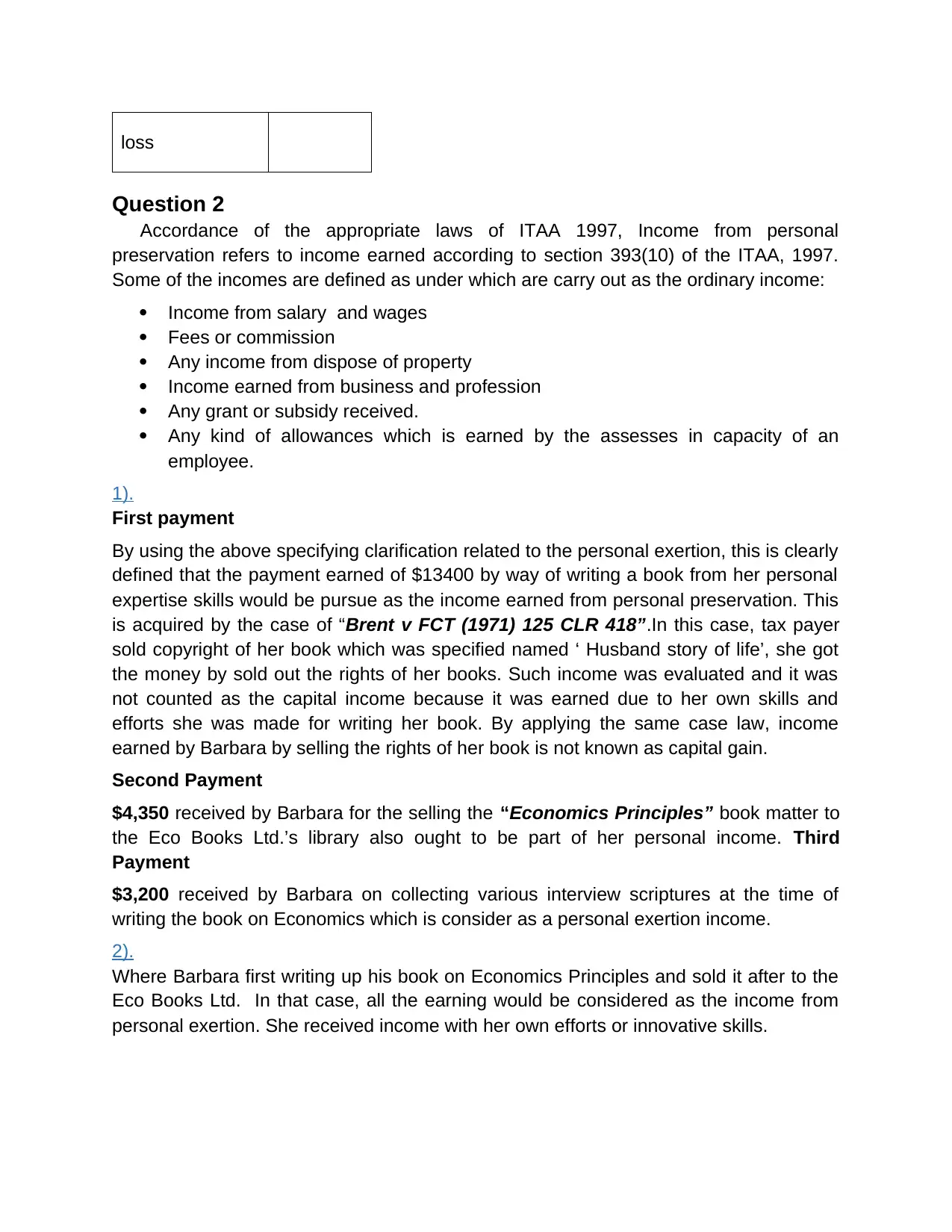
loss
Question 2
Accordance of the appropriate laws of ITAA 1997, Income from personal
preservation refers to income earned according to section 393(10) of the ITAA, 1997.
Some of the incomes are defined as under which are carry out as the ordinary income:
Income from salary and wages
Fees or commission
Any income from dispose of property
Income earned from business and profession
Any grant or subsidy received.
Any kind of allowances which is earned by the assesses in capacity of an
employee.
1).
First payment
By using the above specifying clarification related to the personal exertion, this is clearly
defined that the payment earned of $13400 by way of writing a book from her personal
expertise skills would be pursue as the income earned from personal preservation. This
is acquired by the case of “Brent v FCT (1971) 125 CLR 418”.In this case, tax payer
sold copyright of her book which was specified named ‘ Husband story of life’, she got
the money by sold out the rights of her books. Such income was evaluated and it was
not counted as the capital income because it was earned due to her own skills and
efforts she was made for writing her book. By applying the same case law, income
earned by Barbara by selling the rights of her book is not known as capital gain.
Second Payment
$4,350 received by Barbara for the selling the “Economics Principles” book matter to
the Eco Books Ltd.’s library also ought to be part of her personal income. Third
Payment
$3,200 received by Barbara on collecting various interview scriptures at the time of
writing the book on Economics which is consider as a personal exertion income.
2).
Where Barbara first writing up his book on Economics Principles and sold it after to the
Eco Books Ltd. In that case, all the earning would be considered as the income from
personal exertion. She received income with her own efforts or innovative skills.
Question 2
Accordance of the appropriate laws of ITAA 1997, Income from personal
preservation refers to income earned according to section 393(10) of the ITAA, 1997.
Some of the incomes are defined as under which are carry out as the ordinary income:
Income from salary and wages
Fees or commission
Any income from dispose of property
Income earned from business and profession
Any grant or subsidy received.
Any kind of allowances which is earned by the assesses in capacity of an
employee.
1).
First payment
By using the above specifying clarification related to the personal exertion, this is clearly
defined that the payment earned of $13400 by way of writing a book from her personal
expertise skills would be pursue as the income earned from personal preservation. This
is acquired by the case of “Brent v FCT (1971) 125 CLR 418”.In this case, tax payer
sold copyright of her book which was specified named ‘ Husband story of life’, she got
the money by sold out the rights of her books. Such income was evaluated and it was
not counted as the capital income because it was earned due to her own skills and
efforts she was made for writing her book. By applying the same case law, income
earned by Barbara by selling the rights of her book is not known as capital gain.
Second Payment
$4,350 received by Barbara for the selling the “Economics Principles” book matter to
the Eco Books Ltd.’s library also ought to be part of her personal income. Third
Payment
$3,200 received by Barbara on collecting various interview scriptures at the time of
writing the book on Economics which is consider as a personal exertion income.
2).
Where Barbara first writing up his book on Economics Principles and sold it after to the
Eco Books Ltd. In that case, all the earning would be considered as the income from
personal exertion. She received income with her own efforts or innovative skills.
⊘ This is a preview!⊘
Do you want full access?
Subscribe today to unlock all pages.

Trusted by 1+ million students worldwide
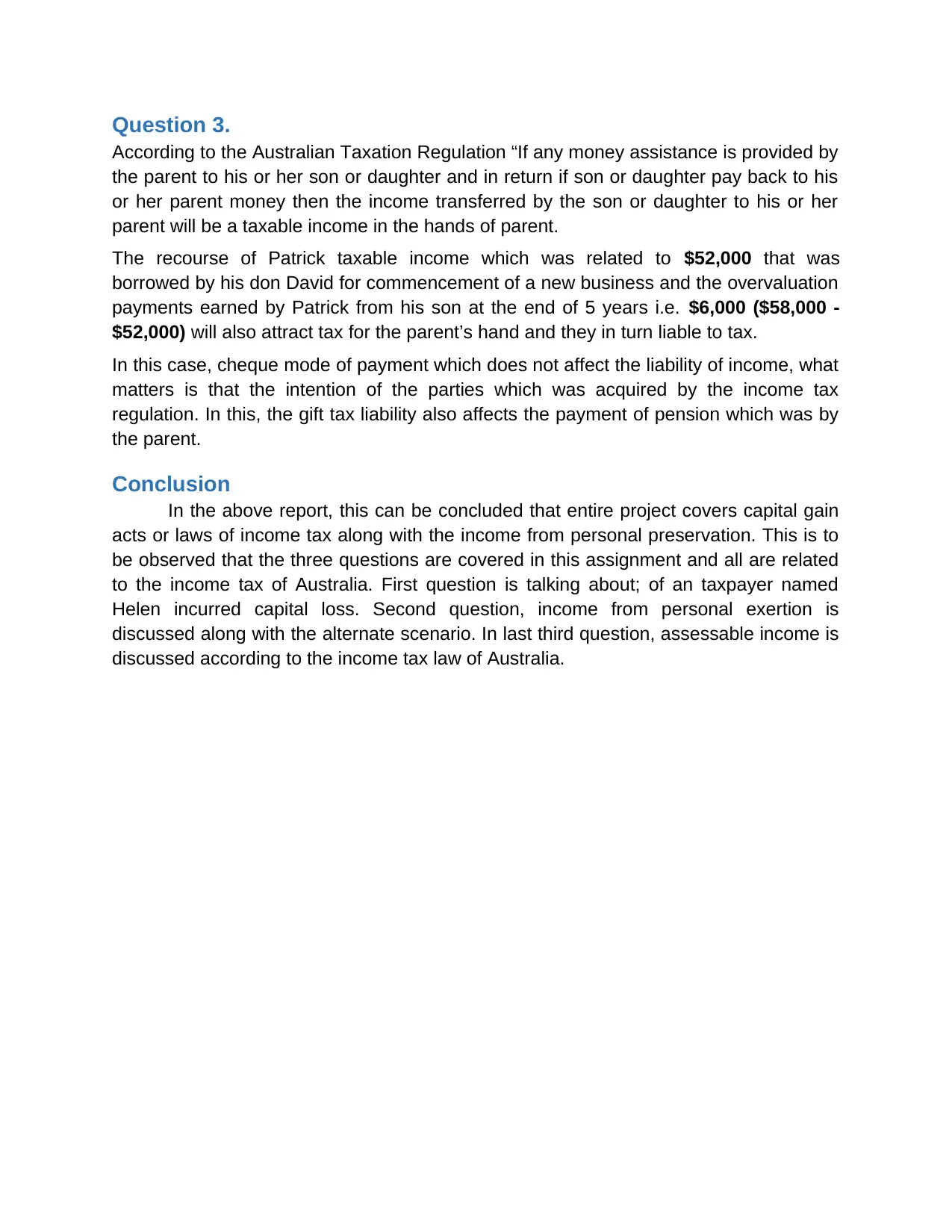
Question 3.
According to the Australian Taxation Regulation “If any money assistance is provided by
the parent to his or her son or daughter and in return if son or daughter pay back to his
or her parent money then the income transferred by the son or daughter to his or her
parent will be a taxable income in the hands of parent.
The recourse of Patrick taxable income which was related to $52,000 that was
borrowed by his don David for commencement of a new business and the overvaluation
payments earned by Patrick from his son at the end of 5 years i.e. $6,000 ($58,000 -
$52,000) will also attract tax for the parent’s hand and they in turn liable to tax.
In this case, cheque mode of payment which does not affect the liability of income, what
matters is that the intention of the parties which was acquired by the income tax
regulation. In this, the gift tax liability also affects the payment of pension which was by
the parent.
Conclusion
In the above report, this can be concluded that entire project covers capital gain
acts or laws of income tax along with the income from personal preservation. This is to
be observed that the three questions are covered in this assignment and all are related
to the income tax of Australia. First question is talking about; of an taxpayer named
Helen incurred capital loss. Second question, income from personal exertion is
discussed along with the alternate scenario. In last third question, assessable income is
discussed according to the income tax law of Australia.
According to the Australian Taxation Regulation “If any money assistance is provided by
the parent to his or her son or daughter and in return if son or daughter pay back to his
or her parent money then the income transferred by the son or daughter to his or her
parent will be a taxable income in the hands of parent.
The recourse of Patrick taxable income which was related to $52,000 that was
borrowed by his don David for commencement of a new business and the overvaluation
payments earned by Patrick from his son at the end of 5 years i.e. $6,000 ($58,000 -
$52,000) will also attract tax for the parent’s hand and they in turn liable to tax.
In this case, cheque mode of payment which does not affect the liability of income, what
matters is that the intention of the parties which was acquired by the income tax
regulation. In this, the gift tax liability also affects the payment of pension which was by
the parent.
Conclusion
In the above report, this can be concluded that entire project covers capital gain
acts or laws of income tax along with the income from personal preservation. This is to
be observed that the three questions are covered in this assignment and all are related
to the income tax of Australia. First question is talking about; of an taxpayer named
Helen incurred capital loss. Second question, income from personal exertion is
discussed along with the alternate scenario. In last third question, assessable income is
discussed according to the income tax law of Australia.
Paraphrase This Document
Need a fresh take? Get an instant paraphrase of this document with our AI Paraphraser
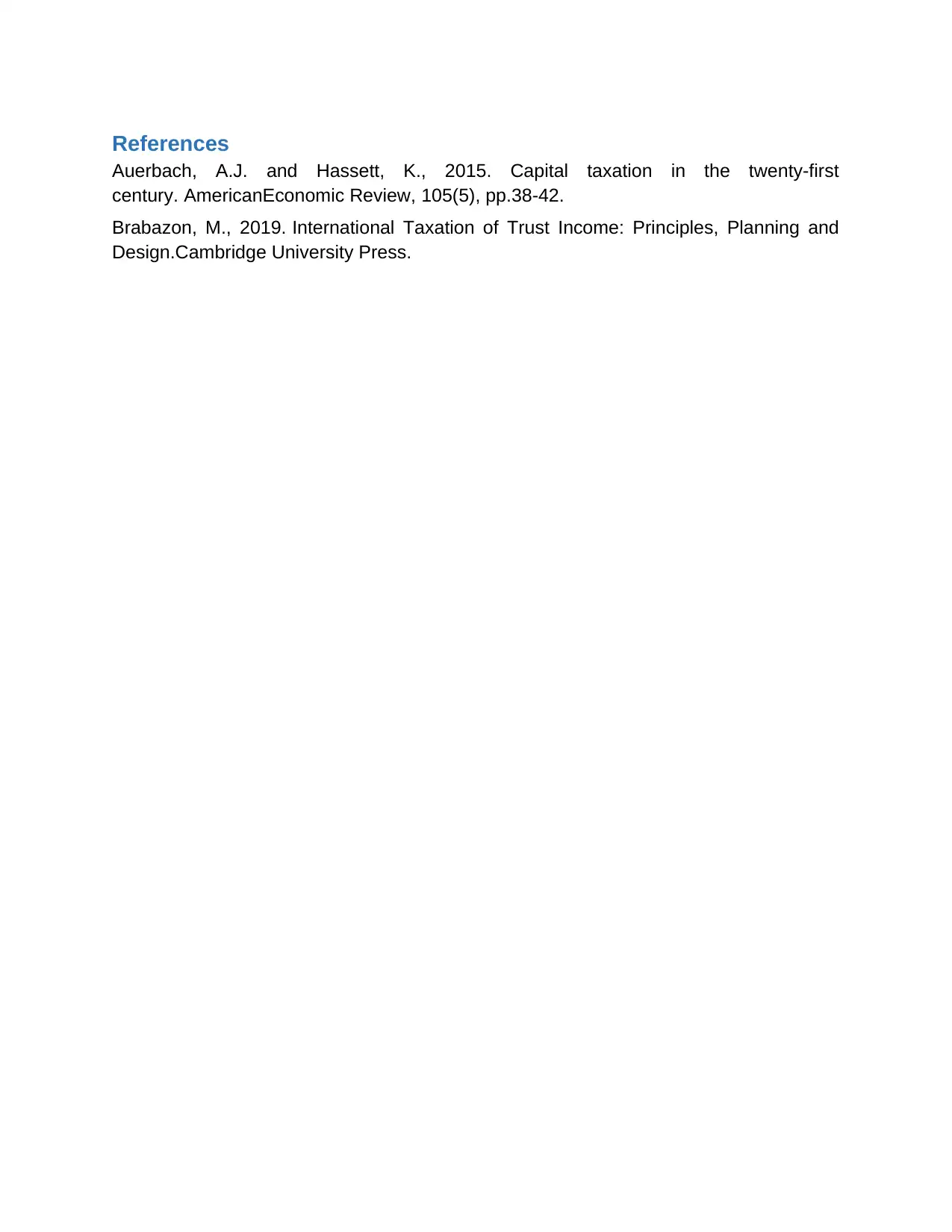
References
Auerbach, A.J. and Hassett, K., 2015. Capital taxation in the twenty-first
century. AmericanEconomic Review, 105(5), pp.38-42.
Brabazon, M., 2019. International Taxation of Trust Income: Principles, Planning and
Design.Cambridge University Press.
Auerbach, A.J. and Hassett, K., 2015. Capital taxation in the twenty-first
century. AmericanEconomic Review, 105(5), pp.38-42.
Brabazon, M., 2019. International Taxation of Trust Income: Principles, Planning and
Design.Cambridge University Press.
1 out of 8
Related Documents
Your All-in-One AI-Powered Toolkit for Academic Success.
+13062052269
info@desklib.com
Available 24*7 on WhatsApp / Email
![[object Object]](/_next/static/media/star-bottom.7253800d.svg)
Unlock your academic potential
Copyright © 2020–2025 A2Z Services. All Rights Reserved. Developed and managed by ZUCOL.





